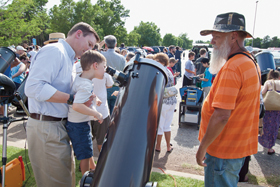Glimpse of rare Venus transit draws spectators


Chris James/Pioneer
Oklahoma City Astronomy Club member, David Love, lets Grant and his son Lucky view the transit of Venus through his telescope on June 6 at a public viewing held at Science Museum Oklahoma. Love has been a member since 2005 and says that he is drawn to the mystery of it all.
The Oklahoma City Astronomy Club partnership with Science Museum Oklahoma, hosted a transit-of-Venus public viewing June 5 in the museum parking lot.
Members of the club set up telescopes allowing attendees of the free event to view the planet as it was passing between the Earth and the Sun.
People of all ages turned out to witness the only occurrence of the transit within our lifetimes to be viewed from Oklahoma.
Venus became visible as a small black disc crossing the sun in the upper right corner at around 5 p.m. in Oklahoma City, and not even the late afternoon heat could stifle the excitement of those gathered.
Spectators were able to see the transit directly through telescopes, on telescope-connected computer monitors, or discs that had the image projected onto it. Eclipse shades were also available, although without magnification viewing Venus as it passed was difficult.
The Oklahoma City Astronomy Club and Science Museum Oklahoma’s planetarium staff had a tent set up to provide information and assistance to those in attendance.
Planetarium Lecturer Bill Wilburn said the event had a good turnout. Wilburn is known as “The Teacher of the Sky” around the planetarium.
Those that arrived later had their view obscured by a patch of cloud cover that rolled in around 6:30 p.m., but this didn’t seem to deter anyone waiting for an opportunity to see the amazing event peek through the lingering haze of clouds.
Historically, the transit of Venus, paired with the principle of parallax, or the visual displacement of an object as viewed along different lines of sight, was instrumental in giving 17th and 18th century explorers and astronomers a glimpse at the true scale of our solar system.
Because the orbital paths of Earth and Venus, the transit happens in a pair of occurrences separated by 8 years. The last one was in 2004. The pairs of occurrences are then separated by over a century.
The next is predicted for December of 2117.
Those that made it out should really consider themselves lucky to have witnessed it with their own eyes. It really illustrated how amazingly complex our universe is, and how small we really are.
Rating: A+
—Chris James
Staff Writer
To contact Chris James, email pioneerphotog@occc.edu.